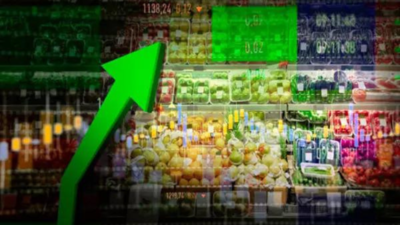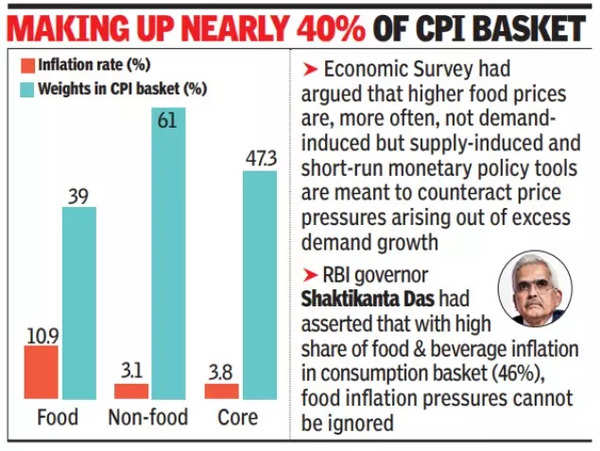Welcome To Latest IND >> Fastest World News
The sharp spike in
retail inflation
rate in October to a 14-month high of 6.2% has triggered a fresh debate about the country’s inflation targeting framework and whether
food prices
should be excluded while setting interest rates. Finance minister Nirmala Sitharaman has called for more discussion on using
interest rates
to control food prices and asserted that govt was taking steps to control food supply side issues. Her comments came shortly after commerce and industry minister Piyush Goyal said targeting food prices through interest rates was an “absolutely flawed theory.” Chief economic adviser V Anantha Nageswaran said that removing tomato, onion, potato, gold and silver from the calculation reveals a headline CPI rate of just 4.2% in October.
TOI looks at the issues linked to the debate:
Why are food prices in focus?
Prices of tomato, onion and potato (TOP) have pushed the retail inflation higher and above the central bank’s upper tolerance level of 6%. Supply side issues have been blamed for the price increase and there are expectations that the situation will reverse once supplies normalise. Food prices have led to seasonal spikes, complicating the overall retail inflation situation. Economists say
food inflation
cannot be ignored as it has a high weight in the consumer price index (CPI) basket and persistent high food inflation raises inflationary expectations. Food inflation has remained high in the country over the past two years, complicating the policy choice.
What is the Monetary Policy Framework?
The RBI Act was amended in May 2016 for providing a statutory basis for rolling out the inflation targeting framework for five years. The Centre and RBI finalise the inflation target based on the consumer price index. It has set a 4% inflation target with the upper tolerance limit at 6% and the lower level at 2%. In March 2021, it has retained the target and the tolerance for the next five years up to March 31, 2026.
How Economic Survey’s views on re-examining the inflation targeting framework sparked the debate?
The latest Economic Survey had suggested excluding food prices from the inflation targeting framework. It had argued that higher food prices are, more often, not demand-induced but supply-induced and short-run monetary policy tools are meant to counteract price pressures arising out of excess aggregate demand growth. “Deploying them to deal with inflation caused by supply constraints may be counterproductive. Therefore, it is worth exploring whether India’s inflation targeting framework should target the inflation rate excluding food,” said the document authored by Nageswaran.
It said that hardship caused by higher food prices for poor and low-income consumers can be handled through direct benefit transfers or coupons for specified purchases valid for appropriate durations.
Why food inflation pressures cannot be ignored?
RBI governor Shaktikanta Das in his monetary policy statement had said that the monetary policy committee’s target is the headline inflation where food & beverage inflation has a weight of around 46%. He had asserted that with this high share of food in the consumption basket, food inflation pressures cannot be ignored. Das had said that the public at large understands inflation more in terms of food inflation than the other components of headline inflation. “Therefore, we cannot and should not become complacent merely because core inflation (stripping out food and fuel) has fallen considerably,” the governor had said.
The governor had said that high food inflation adversely affects household inflation expectations, which have a significant impact on future trajectory of inflation. RBI is of the view that stubborn high food inflation and unanchored inflation expectations – if they materialise – could lead to spillovers to core inflation through pick-up in wages on cost-of-living considerations.
“The MPC may look through high food inflation if it is transitory; but in an environment of persisting high food inflation, as we are experiencing now, the MPC cannot afford to do so. It has to remain vigilant to prevent spillovers or second round effects from persistent food inflation and preserve the gains made so far in monetary policy credibility,” Das had said.
Latest IND



